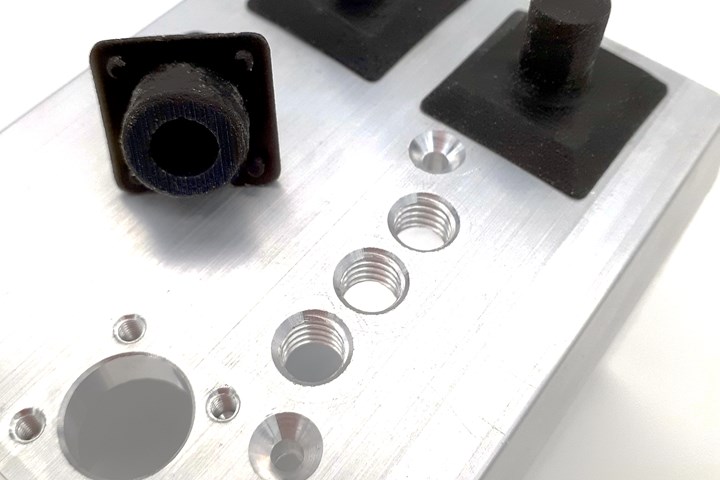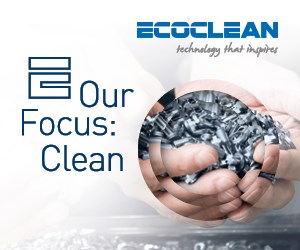
Custom masking solutions can seem daunting and expensive, but they don’t have to be.
Photo Credit: Custom Fabricating & Supplies
Q: When should I consider a custom masking solution vs. an off-the-shelf masking option?
A: There are many suppliers for standard masking options — caps, plugs, and tape. Once you have exhausted those options and the solutions still aren’t there, where do you turn? If time and budget allow, both custom molded rubber and custom die cuts are great options. But what if you are short on time or your order sizes don’t justify the cost for custom tooling?
Custom masking solutions can seem daunting and expensive with long lead times. With today’s technologies, they don’t have to be. If you need a specialized masking option in a short amount of time, there are options available using a converting company that has invested in the latest advancements.
For complex assemblies, ideally, you have an engineered file of the part you want to mask. File extensions would include .stp, .iges and .parasot. Once the mask has been designed by in-house experts, the next step is sampling the design. This provides an opportunity for testing prior to investing in tooling fees.
For molded products, that first sample is often a 3D-printed part. While most 3D printing materials are not designed to withstand the heat and/or chemicals associated with finishing processes, they are helpful to determine basic fit and function. 3D printing has come a long way, and using a high-end 3D Polyjet printer is ideal. PolyJet printers use soluble, gel-like support material, making them capable of very complicated geometries. While they cannot yet print true silicone, they can offer similar materials, tight tolerances, and different durometers (hardnesses) for unparalleled prototyping capabilities.
For many custom tape die-cuts, there exists the opportunity for free samples provided that the material is not a special order. These samples can be produced on a plotter — or digital cutting machine — often the same day they are ordered. Examples of tapes and die cuts that usually can be sampled at no cost include green polyester, crepe tapes and some polyimides. This machine does not require tooling, so it is also ideal for small runs of custom tape die cuts.
For materials such as foam or VHB tapes, plotting is not an option due to their thickness. In this case, there are other dieless sampling options available through flash cutting and laser cutting. Generally, there is some set-up time that is charged, however, it will still be less than standard die charges and there is no waiting for tooling to be manufactured.
When using flash cutting, both sheet and sponge silicone can be easily converted into custom masking in a fraction of the time needed to ramp up with traditional mold tooling. Lead times for production molded parts can easily exceed 20 weeks when looking at a start-to-finish delivery. With flash cutting, everything is produced digitally. Lead times are usually a couple of weeks instead of several months start-to-finish.
Complex shapes can also be achieved through a milling process that some converters have on their flash machines. This allows for 3D shapes to be produced that previously were only achievable through a molding process. To replicate a molded 3D part, layers of material are removed in a process similar to milling a piece of wood or metal. For short production runs, this process can be a game changer, as the expenses for hard tooling can be extensive. The set-up fees for digital production are a fraction of the custom mold costs.
Laser die cutting is another great technology that can be leveraged for rapid prototyping and dieless manufacturing. The laser’s claim to fame is that it can create intricate, tricky patterns that would be difficult, or impossible, for a traditional rotary die-cutting machine to produce. Like flash cutting, laser cutting doesn’t require hard tooling, so it’s ideal if you want to create a quick prototype. This highly repeatable method enables the smallest holes, slots and perforations to be cut with precision. Undesirable material can also be removed from each part through ablation.
Understanding your converting partner’s capabilities can help you adjust lead times and cost expectations. If you need fast and precise, be sure to select a company that has invested in the latest technology. When time is of the essence, don’t get left behind.
About the Author

Christy Schulthess
Christy Schulthess is the marketing director for Custom Fabricating & Supplies. Visit customfabricate.com.
Related Content
How to Choose the Right Coating for Fasteners
Choosing the proper coating for fasteners can help with performance by improving durability and lifespan. In this helpful Ask the Expert article, Mark Schario of Columbia Chemical offers advice for choosing the right fastener coatings.
Read MoreHow to Choose Between Sulfate and Chloride-Based Trivalent Chromium
There are several factors to consider when choosing between sulfate and chloride-based baths for trivalent chromium plating. Mark Schario of Columbia Chemical discusses the differences and what platers should keep in mind when evaluating options.
Read MoreTop Reasons to Switch to a Better Cleaning Fluid
Venesia Hurtubise from MicroCare says switching to the new modern cleaning fluids will have a positive impact on your cleaning process.
Read MoreOutgassing and Powder Coating Defects
Having trouble with bubbles forming during curing? Verney Denerville of TIGER Drylac discusses proper outgassing procedures.
Read MoreRead Next
Episode 42: An Interview with Robin Deal, Hubbard-Hall
Hubbard-Hall wastewater treatment specialist Robin Deal discusses the latest trends in wastewater management.
Read MoreThe 2024 Ford Mustang: All the Colors Available
Although Chevrolet has announced the end of the Camaro and Dodge is offering “Last Call” editions of the Charger and Challenger, the Ford Mustang is launching to its seventh generation.
Read MorePowder Coating 4.0: Smarter, Faster, More Efficient and Connected
New tools reduce cost and waste, lower manufacturing footprint of powder coating operations.
Read More

























